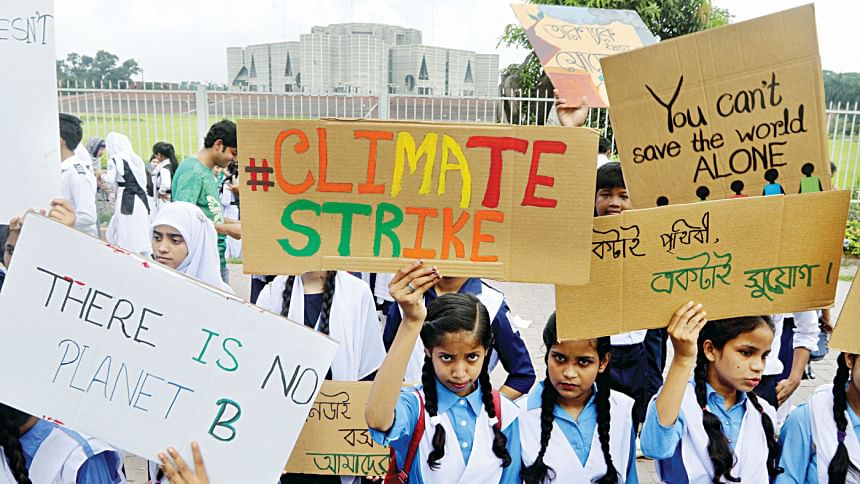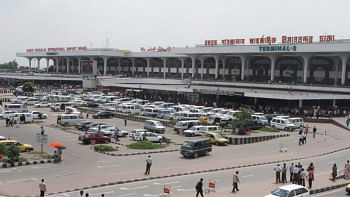Writing just climate transition: A reporter’s notes

In his work on the climate crisis, historian Dipesh Chakrabarty speaks of two kinds of time --- a human time of phenomenologically meaningful events that converged a few centuries ago into a globality on the back of techno-economic transformations, and a deeper geobiological time of the planet that is not centered on humanity. The humanocentric globe - made up of nation-states, corporations, and social groups - is now trying to cobble together a climate transition to prevent the ruination of its deeper planetary entanglements necessary for its survival. It is now dawning on the modern, globalized humanity –- a 'planetary force' – that they need to wield their agency for reining in the ruinous processes of climate change, biodiversity loss, and manifold ways of degrading our habitat.
Climate journalists grapple with the asynchrony of these two timelines. They chronicle on the one hand how the evermore rapid and irreversible heating up of the atmosphere is harming the earth's human and non-human denizens, and on the other hand, how actors with decisive power are timing their responses for containing the threat. The crucial problem, Chakrabarty tells us, is that while the earth's 'system' is arguably one, humanity is not one in any conceivably concrete way.
Humans are, thus, a pharmakonic agency who now have a Noah-like, messianic responsibility of "katechoning" the coming great extinction or omnicide –- if only they could unite and enact their agency as a concrete-universal. Dipesh Chakrabarty urges us to make kin across our myriad differences based on our being common as "earthbound" creatures.
One climate problem and disunited humanity: that is where 'just transition' comes into the picture. Indeed, even if the world united in making timely and transformative decisions about containing the climate crisis, the "how" of the process could still be a divisive matter as different interests and desires about our climate future are often stacked against each other and the fairness of any action could be on that account contested. The justness of the climate transition is thus, a political problem.

The concept of just transition had its origin in labor activism in the 1980s in the United States, where the main concern was whether the environmental transition would negatively affect workers. Linking climate change and labor rights is thus a crucial originary aspect of just transition. In places like Bangladesh, the climate-labor nexus is not well integrated either in policy-making or development programming given the often fragmented pattern of governance. As a climate-vulnerable land and a peripheral economy, Bangladesh has moved fast to develop a set of detailed strategies and policies for tackling climate challenges, but there is no adequate policy guidance on how workers of industries like the apparel sector would be protected from climate hazards like heat or flooding, or how industry and local governments could join hands to create decent adaptation opportunities for climate migrants in cities and towns.
In just transition newsrooms, the intersectional lens is applied in making news about the three main types of climate action: cutting carbon emissions, helping people cope with rising hazards, and instituting reparations for the harms people nevertheless suffer due to climate change. Changes are traced in a wide array of sectors like energy, industry, agriculture, transport, and so on.
A key metric of just transition is counting and weighing the brown jobs in fossil fuel-backed sectors that will have to be phased out as opposed to the green or mixed jobs that should be phased in as decent livelihoods. Given the sprawling informality in peripheral economies, 'green jobs' can be sometimes hard to count or measure, and a broader notion of livelihood may be more useful if it encompasses the domestic sphere as well where many women "give" unpaid labor and care.
Building upon such caveats and correctives, the scope of 'just transition' has over time expanded beyond climate-labor linkage and turned into a broader intersectional problem that pays attention to gender, class, race, indigeneity, and other potential forms of differentiality that present myriad forms of otherness within the human family. Indeed, the very concept "communities" – in sociological parlance gemeinschaft – seen as survivors as well as agents concerning the climate crisis, is necessarily sublated with the intersectional problem of just transition, since the same solutions to climate-induced problems can affect men and women, the rich and the poor, or urban and rural people differently.
In the international political economy made up of rich and poor nations, just transition is also linked with international climate justice. As Chakrabarty mentions in relation to countries like India or China - these countries claim a certain "carbon space" for raising their socio-economic levels while the planetary climate problem should be primarily taken care of by the rich countries. Meanwhile, richer countries point at the growing share of carbon emissions by developing giants. This rift – annually dramatized in the COP debates – relativizes the link between climate and development. What is true for developing giants is also relevant for Bangladesh, mutatis mutandis, a country that aspires to become a developed country by 2041 with extensive urbanization and significant growth of per capita energy use. Chakrabarty argues that such national developmental aspirations should not merely be read off as mimetic desires passively modeled on original Western modernity, but should be understood as the non-West's self-fashioning (repetition as difference). This suggestion alerts us to how the intra-national, national, and international collide in the space of the complex political ontology of the climate-development nexus.
The often-paradoxical entanglement of developmental telos and climatic nightmares entails the further question of just adaptation. As geographer Kacia Paprocki warns, the epistemology of climate action itself can be geared toward particular teleologies of what is viable and nonviable in the imaginable future. Epistemic biases and vested interests of powerful actors involved in knowledge production and ground-level interventions can often lead to what Paprocki calls anticipatory ruination, i.e., the adaptive process itself precipitating the ruin it sought to help people against. Having done her ethnographic work in coastal Bangladesh and West Bengal, she notes that sometimes key adaptation measures demanded by the marginalized communities – such as peasants calling for land redistribution – are not even considered as an option. Ideas like participatory planning, locally led adaptation, or engaging community-based organizations are salutary if people on the ground can be critical of the processes without fearing punitive consequences. Community voices should not be filtered and curated only to suit preconceived solutions.
In this complex unfolding, the media's role is primarily to represent what is happening objectively and impartially. However, what happens on the ground is entangled with how people think about what exists and what needs to be done. Language and concepts are essential ontological tools that shape our practice, and media can have an important role in setting agendas and framing issues as they make choices about the representations. In other words, beyond reporting just transition, the media itself is a secondary actor in enabling just transition, triggering conversations that would otherwise not happen – bringing together perspectives from actors, experts, and marginalized people. Media can shine a spotlight on the invisible and the subaltern as a matter of affirmative justice by curating and counter-curating the voices of the most vulnerable groups.
A major challenge for reporting just transition arises from the phatic and the performative conditions of reporting. Institutions that can provide or gatekeep access to information may often seek to attach strings while granting access, expecting favorable reporting in return. A related phenomenon is what media observers informally call "churnalism", whereby sections of media uncritically derive their stories from motivated or one-sided content developed by the PR wings of a business, a ministry, or a lobby group – a pattern that would reduce news production itself to a phatic token of exchange. Journalists need to guard against such active or passive attempts at platform capture and instead seek to cultivate a media ecology that harnesses fairness and objectivity.
Raising questions about the actions of powerful actors is thus stock-in-trade for climate journalism. A fundamental insight of the environmental movement was that powerful economic actors (e.g., large corporations) often treat the costs of their ecological footprint as an externality, but such externalization may also assume international dimensions. As the geographer Laurie Parsons argued: rich countries often exported carbon-emitting production activities abroad, and since climate accounting ignores consumption-based emissions, this helped them appear cleaner than they are. Recent legislation in Europe and the US holding corporations responsible for supply chain emissions (scope 3) are important steps towards addressing this inequity.
Aside from these universal aspects of climate journalism, there are also deep asymmetries across societies that journalism needs to be sensitive to. One such asymmetry pertains to the realm of language. There is no justice beyond the realm of language, even though justice is inevitably elusive to hegemonically-configured language. Most of the discursive transactions on climate change happen in particular Western languages, while vernacular languages are often relegated to the task of informing, calquing, and catching up with those privileged language transactions. The up-translation of vernacular phenomenologies of climate change from around the world into English, its processing up there, and then, its down-translation filtering back into vernaculars is itself an interesting process whose fairness bears examination: what gets translated and what gets lost or how lived experiences are processed across idioms and institutional habitues are essential considerations for academic, journalistic and other epistemic work concerned with just transition.
To return to the original theme of human disunity, any "unjust" transition is a sacrificial process of scapegoating vulnerable others – human or non-human beings who cannot articulate their victimhood – to the unfolding planetary catastrophe. Yet, these sacrificial politics are unsustainable and self-defeating as powerful sacrificers and the powerless sacrificed are ultimately beings in common. The climate journalist's task in just transition is to include the voices of those facing the existential risk of being dispensed with. That is how journalism could contribute its two cents for ecological accountability within and across borders.

 For all latest news, follow The Daily Star's Google News channel.
For all latest news, follow The Daily Star's Google News channel. 



Comments